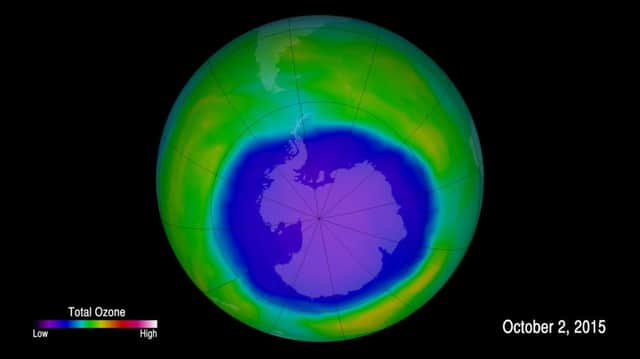Ozone hole over Antarctic is '˜healing' say scientists


In a triumph of international co-operation over a man-made environmental problem, research from the UK and the US shows that the September-October ozone hole is getting smaller and forming later in the year. The study in the journal Science also shows other indications that the ozone layer is improving after it was being eaten away by chemicals in aerosols and refrigerants. Ozone is a combination of three oxygen atoms; high in the atmosphere, it shields Earth from ultraviolet rays.
The hole has shrunk by about 1.7 million square miles in the key month of September since the year 2000 – a decline of about one-fifth – the study found. . It also is taking about ten days longer to reach its largest size.
Advertisement
Hide AdAdvertisement
Hide AdThe hole won’t be completely closed until mid-century, but the healing is appearing earlier than scientists expected, said study lead author Susan Solomon of MIT. “It isn’t just that the patient is in remission,” Solomon said. “He’s actually starting to get better. The patient got very sick in the 1980s when we were pumping all that chlorine into the atmosphere.
“I think it’s a tremendous cause for hope for fixing other environment problems, such as man-made climate change,” said Solomon, who led two US Antarctic expeditions to measure the ozone layer in the 1980s and has also been a leader in studying global warming.
In the 1970s, scientists suggested that Earth’s ozone layer – about six to 30 miles high in the stratosphere – was thinning because of chemicals chlorofluorocarbons from aerosols and refrigerants.
Those chemicals would break down into chlorine that attacked ozone, which at that level protects people from ultraviolet rays linked to skin cancer. Then in early 1980s, a hole in the ozone layer over Antarctica started appearing in October – and then, September and October – making the problem more urgent.
Ozone thinned elsewhere on Earth and already has begun healing in the middle section of the planet, but the Antarctic ozone hole was the gaping wound that grabbed the world’s attention.
The Montreal Protocol, a 1987 global treaty to phase out many of the ozone-depleting chemicals, led companies to develop new products. Still, scientists said it would take time before the problem would heal. Now it is getting better, not just stabilising, based on observations using different methods to measure the ozone layer, Solomon said.